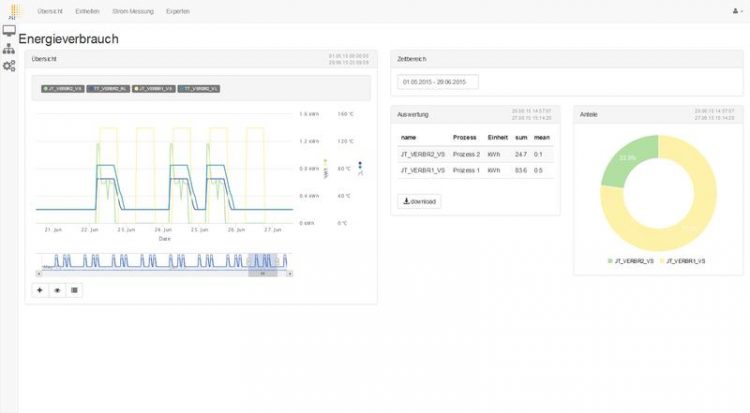Energy-Efficient Building Operation: Monitoring Platform MONDAS Identifies Energy-Saving Potential

The web-based data visualization of the energy monitoring platform MONDAS provides a multitude of displaying possibilities that can be configured and structured easily by the user. ©Fraunhofer ISE
Through continuous and automated supervision of the operation of building services, significant energy savings can be reached. Optimization takes economical aspects into account and focuses on energy costs, thermal comfort and effective energy and facility management. Often even inexpensive measures have a significant effect on energy efficiency and building operation costs.
This especially applies for existing offices and commercial buildings, where for instance often only minimal changes in the parameters of the Building Automation System are necessary to improve the building operation. “It is crucial for the building operators to evaluate large amounts of data with an efficient and comprehensive software, in order to quickly identify energy saving potentials and to organize corrective measures”, explains Nicolas Réhault, Head of Group Building Performance Optimization at Fraunhofer ISE.
“With the energy monitoring platform MONDAS, we provide this target group with a high-performance tool.” The energy monitoring platform was developed by Fraunhofer ISE and PSE AG, and is available from both partners upon request.
Data collection
The data collection module of MONDAS is a flexible interface for different measuring devices and protocols regarding building operation. The basis for this is a fully configurable, expandable basic implementation that connects to the existing Building Automation and Management Systems over protocols like Modbus TCP, ModbUS RTU, CANopen, BACnet, M-Bus and EIB/KNX, as well as user-specific protocols.
Data management
MONDAS uses the HDF5-Format to store the data collected. This enables access that is up to 100 times faster than in SQL-based relational databases. As a result, even very large data records are highly available for analysis algorithms and visualizations. Furthermore, several databases can be connected to a cluster of data modules via a data protocol. With every time series metadata is saved that describes for instance the sensor or actuator location or the sensor type like e. g. a temperature or pressure sensor. Thereby, the metadata represents the basis for further automated processing steps like e. g Fault Detection and Diagnostics.
Standardized filtering functions
A further key component of the MONDAS platform includes standardized filtering functions that can be interconnected to complex calculations. The standard filters include simple tasks, such as recognition and interpolation of data gaps, comparison of different data sets, as well as complex methods for identification of certain data patterns and correlations. This methodical approach forms the basis for development of data analysis algorithms.
Automatic Fault Detection and Diagnostics
Based on the basic components of MONDAS, Fraunhofer ISE has developed different algorithms for the automated supervision of the energy building operation. They enable the automatic detection and identification of errors and suboptimal states in the operation of building services like heating, ventilation and air conditioning systems. They also provide important insights for energy and facility managers to organize corrective measures. The developed algorithms include a rule-based system based on expert knowledge as well as machine learning methods like e. g. clustering or qualitative models.
Data visualization and analysis results
The web-based data visualization of MONDAS offers a multitude of display options to the user who can configure and structure his interface according to his needs. Visualization options include simple line and bar charts, as well as relational data charts and color gradient charts that make statistical relationships quick and easy to comprehend. Display and parametrization views (Widgets), for example descriptions or equipment overviews, can be arranged in different views. The views allow hierarchical subdivisions, enabling structuring according to the building, equipment or energy flow structure and thus displaying adequate information to support energy and facility management tasks.
Fraunhofer ISE will be presenting its energy monitoring platform, MONDAS, at the BAU trade fair from 16 to 21 January 2017 in Munich. Please visit us at the Fraunhofer-Allianz BAU stand in hall C2, stand 538.
Media Contact
All latest news from the category: Trade Fair News
Newest articles

Witness Groundbreaking Research on Achilles Tendon Recovery
Achilles tendon injuries are common but challenging to monitor during recovery due to the limitations of current imaging techniques. Researchers, led by Associate Professor Zeng Nan from the International Graduate…

Why Prevention Is Better Than Cure—A Novel Approach to Infectious Disease Outbreaks
Researchers have come up with a new way to identify more infectious variants of viruses or bacteria that start spreading in humans – including those causing flu, COVID, whooping cough…

Durable, Efficient, Sustainable: The Rise of Cerium Oxide Thermal Switches
Groundbreaking cerium oxide-based thermal switches achieve remarkable performance, transforming heat flow control with sustainable and efficient technology. Cerium Oxide-Based Thermal Switches Revolutionize Heat Flow Control Thermal switches, which electrically control…



